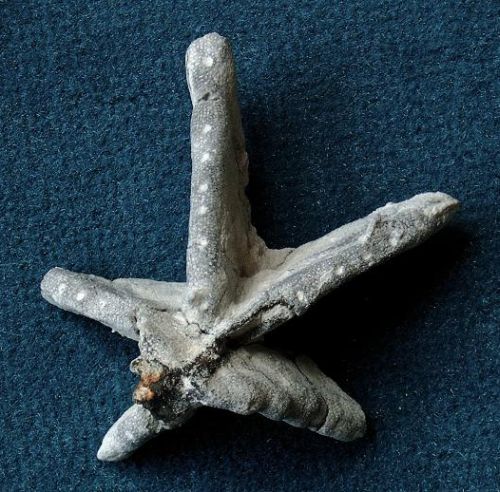
Guettardia striata
Schrammen 1912
Guettardia striata is characteristically folded to produce three to several lobes, imparting a star-like cross section to the sponge.
The specimen shown here (viewed from below) is probably Guettardia striata, which is characterized by typical round openings (parietal oscula) along the edges (see figure).
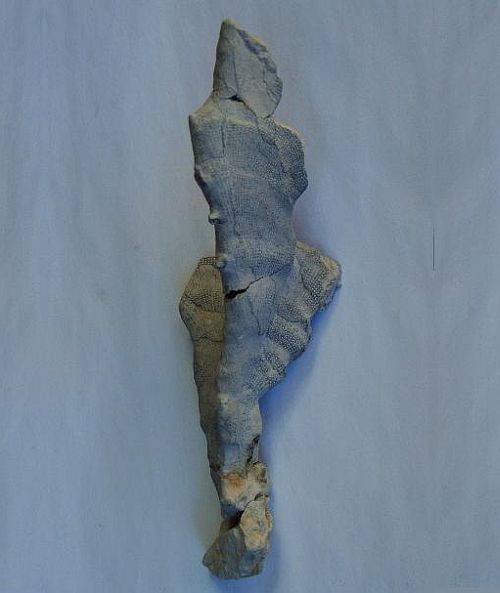
Guettardia trilobata
Roemer 1864
Guettardia trilobata is described for the first time from Misburg.
According to Schrammen (1912), it differs from the other Guettardia species by having longitudinal narrow gaps along the edges (not visible on the picture), which were thought to be homologous to the round openings of the other species. (This interpretation is questionable; see below)

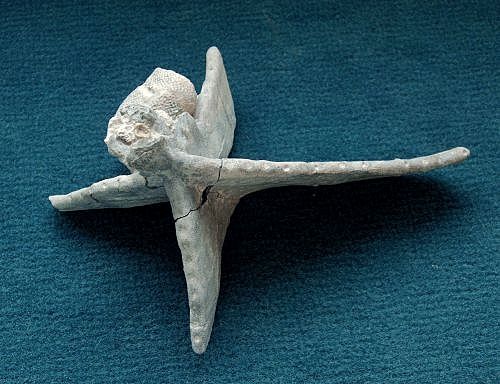
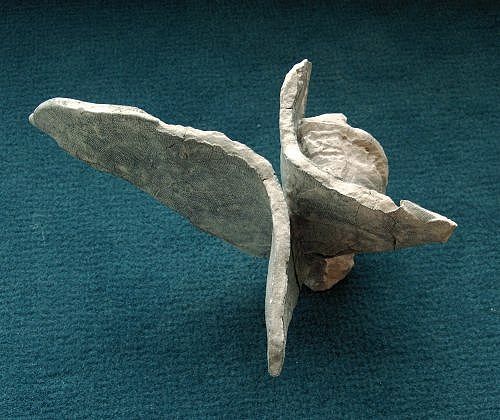
Guettardia bis-alata
Schrammen 1910
Guettardia bis-alata is described for the first time from Höver. The Specimen shown here in three different views (side, bottom, and top) resembles very much a less complete specimen in Moret (1926, Pl XXIV, Fig. 10), although it is much larger.
In the side and top view, it is possible to recognize that the left wing tip is completely preserved, showing a growth margin with incomplete epirhyses and aporhyses on its upper edge. The specimen has a short (20 mm), strong (15 mm) stem and was obviously attached to some organic remains.
Guettardia bis-alata is distinguished from other Guettardia species by is bilateral division into two curved double-wings emerging from a common stem. In its other properties, Guettardia bis-alata is indistinguishable from Guettardia striata, Guettardia trilobata and from the curious Guettardia species described below.
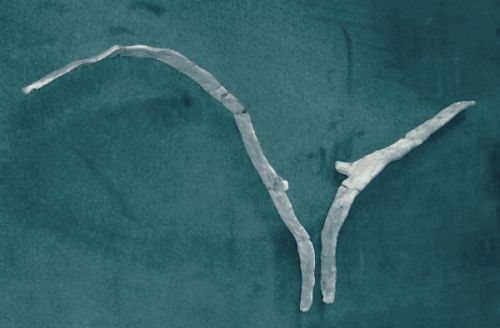
Guettardia sp.
Two very long fragments of a single, branched individual of Guettardia sp.. The branches may have reached up to 1 meter in length, at a width of approx. 30 mm and a thickness of approx. 7 mm.
Both branches have remains of downward oriented side branches (see below).
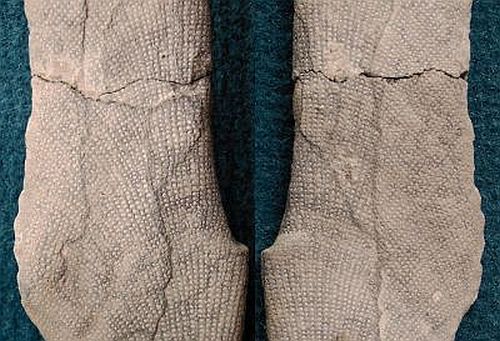
A section of the above specimen, imaged from both sides.
Note that in side view (image pair), the branches are distinctly asymmetrical (contrary to Pleurostoma or Typhlopleura), as indicated by the radiating array of pores. Also, the lateral edges are not equivalent, as illustrated by the images following below. One edge (in the center of the image pair) has the form of a broad, convex fold, whereas the opposite edge is narrover and shows a longitudinal, concave, notch-like suture. In cross section, the branches are slightly tear-shaped rather than oval. The pores are arranged in curved lines which end at an angle of approx. 45 degrees at the concave edge, whereas the angle appears very acute (5 to 10 degrees) against the convex edge.
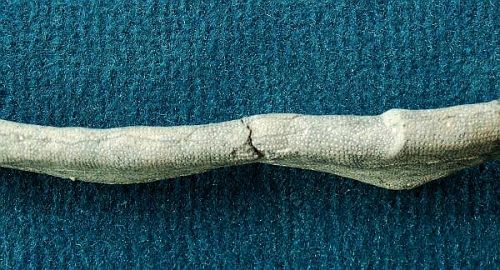
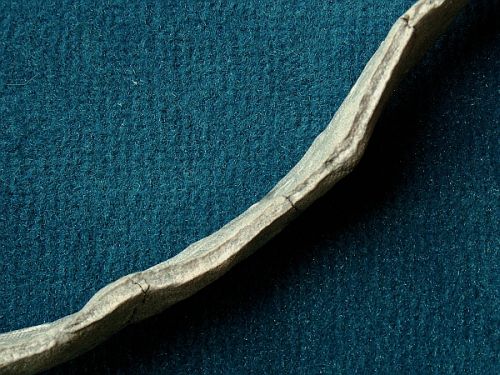
Convex and concave edges of the above specimen of Guettardia sp..
Earlier authors (e.g. Schrammen, 1912) have noted the parietal oscula along the narrow edges of Guettardia species (cf. Guettardia striata above). It now appears that these oscula are present only on the convex lateral edge, but not on the concave edge. Also, as recognizable in the top left picture, these oscules may be quite small (one mm or even less), or even lacking.
All observations taken toghether, it appears that Guettardia is derived from a folded, funnel-shaped sponge whose folds continue to grow in longitudinal direction, forming long, ruler-like branches. Along the edge opposite to the fold hinge, the two sides form a suture which has the shape of a longitudinal notch.
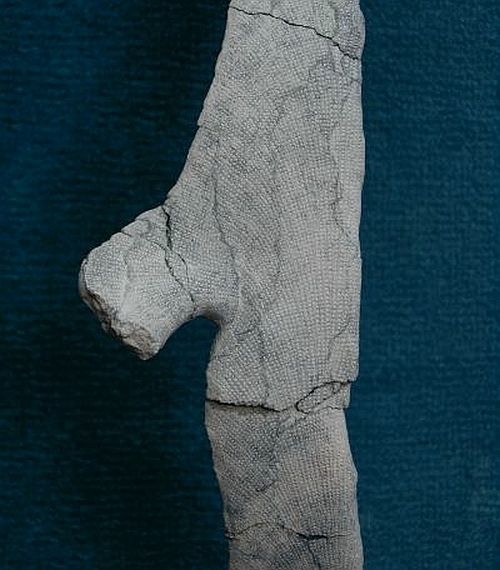
A section of the above specimen, showing development of a side branch. Curiously, the branch initially points downward, but may have become erect in its distal sections. All side branches observed so far emerge from the concave, not the convex longitudinal edge.
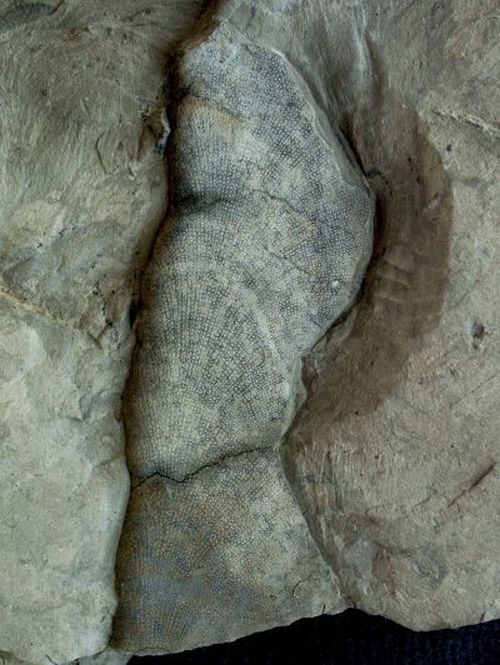
A fragment of Guettardia sp.,showing the typical radiating pattern of pinhole-sized pores.
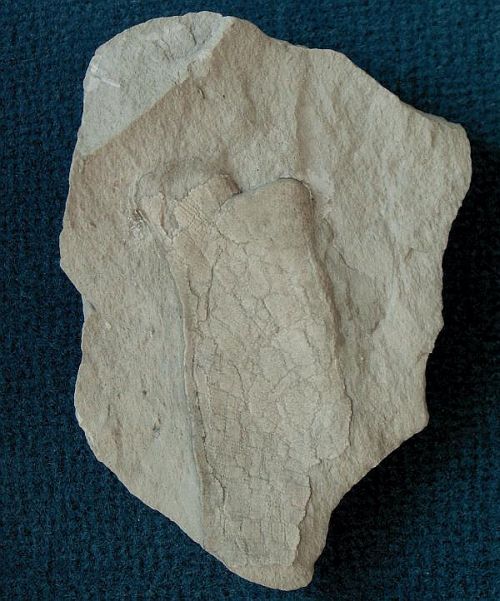
A fragment of Guettardia sp., showing the termination of a wing, which is asymmetrically bifurcated. The two terminal lobes are closed at their ends.
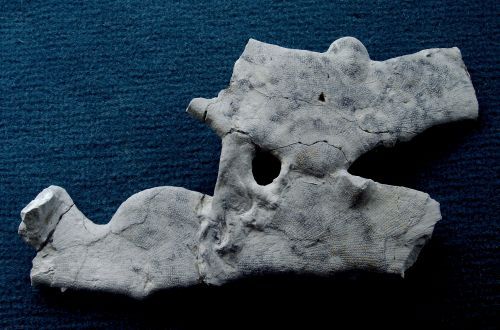
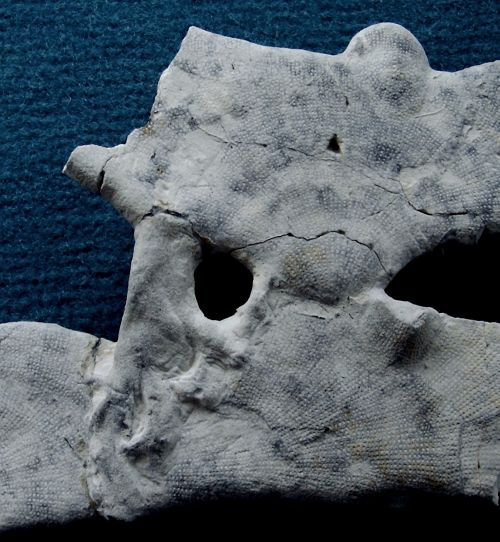
Two images of a complex fragment of Guettardia sp., showing butting and growth of a new individual (top), which spreads out bilaterally and sends out roots which attach to the parent individual (bottom).
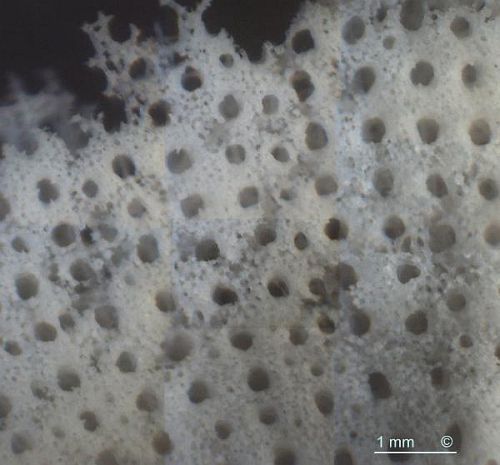
Etched specimen of Guettardia sp., showing arrangement of pores. Notice intercalations of new pore rows in several places, which give rise to the characteristic fan-like pore patterns. Dermal (external) side.
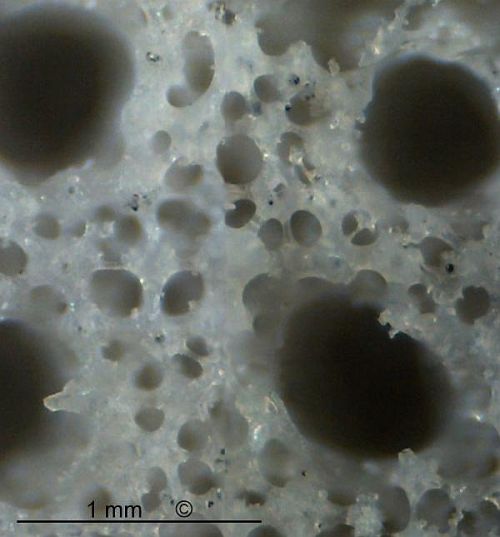
Photomicrograph of etched Guettardia sp. (dermal side), showing network of fused hexactine spicules which form a cortex between ostia.
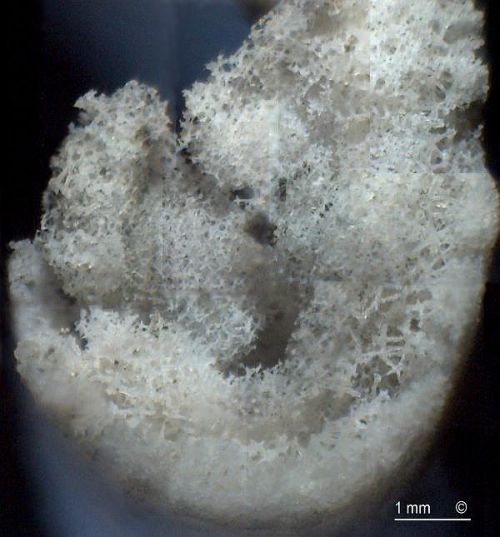
Etched cross fracture of a branch of Guettardia sp., showing dense internal skeletal structure. Notice dense cortex, followed by an intermediate layer of large dictyonal hexactines, and finally a network of smaller hexactines in the center, filling nearly all of the interior cavity. The latter network is considered homologous to a covering layer.
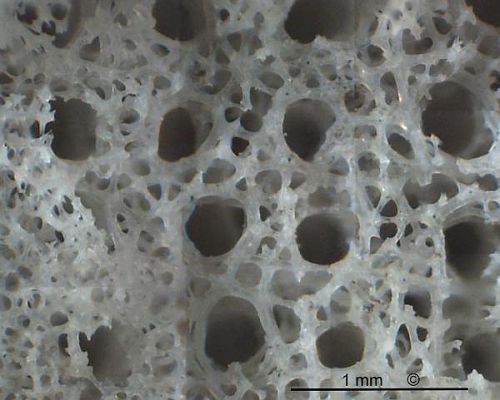
Internal side of the intermediate layer, showing epirhyses formed by large fused hexactines. Notice covering layer of smaller hexactines near the left margin.
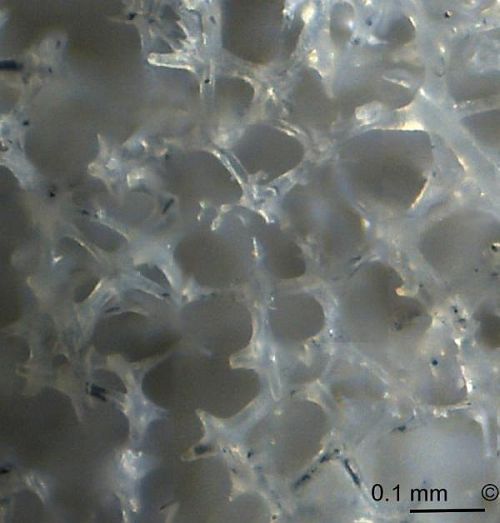
Photomicrograph of network of smaller hexactines.
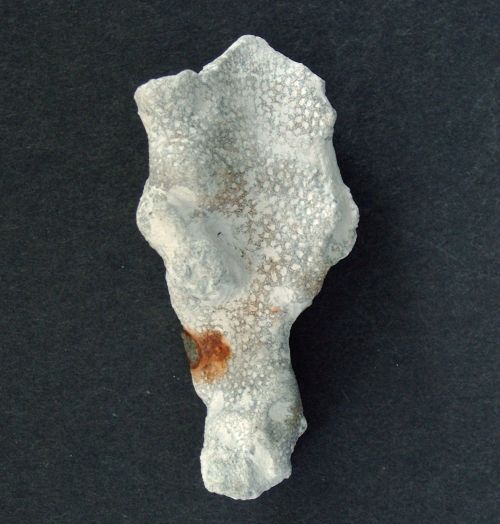
Guettardia stuempeli
Schrammen 1902
Guettardia stuempeli is described for the first time from Höver. Fragments of Guettardia stuempeli, which are difficult to identify, are not very uncommon in the Lower Campanian of Höver, but the species is apparently absent in the Upper Campanian of Misburg.
The general shape of Guettardia stuempeli is similar to that of Guettardia trilobata, but it differs considerably from the other Guettardia species in its skeletal properties. The surface of Guettardia stuempeli feels rough and hackly, due to a larger size and a less developed silica mantling of the dermal skleres. Also the pores and the distances between pores are almost twice the dimensions of the other Guettardia species.
Judging from the fragment sizes that can be found, it appears that Guettardia stuempeli is/was more fragile and brittle compared to the other kinds of Guettardia.
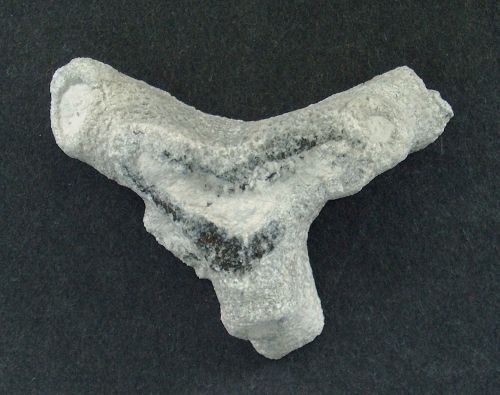
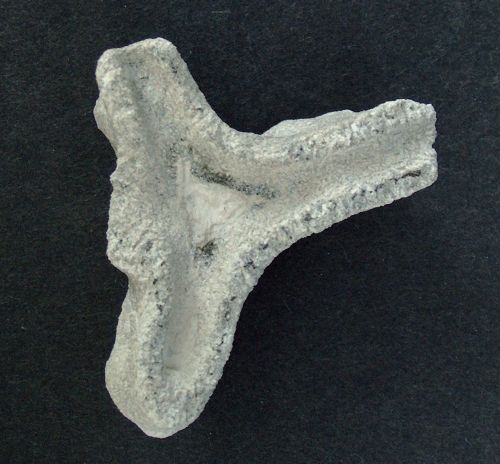
A second fragment of Guettardia stuempeli, shown in bottom and top-view. Notice the triangular symmetry created by the narrowly folded walls.
The parietal oscula on the narrow lateral edges are 3 to 8 mm wide and show a protruding rim (upper image). The lower image shows a cross fracture passing through the canals which terminate in the parietal oscules. The canals connect to an axial passage.